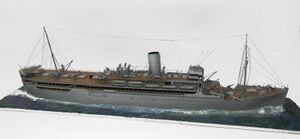Engineering:HMS Rawalpindi
 Scale model of HMS Rawalpindi
| |
| History | |
|---|---|
| Name: | Rawalpindi |
| Namesake: | The city of Rawalpindi (British India) |
| Owner: | Peninsular and Oriental Steam Navigation Company |
| Port of registry: |
|
| Route: | London–Bombay |
| Builder: | Harland and Wolff, Greenock |
| Yard number: | 660[1] |
| Laid down: | 1923 |
| Launched: | 26 March 1925 |
| Completed: | 3 September 1925[1] |
| Homeport: | London |
| Fate: | Requisitioned by Admiralty, 24 August 1939 |
| Name: | HMS Rawalpindi |
| Acquired: | 24 August 1939 |
| Commissioned: | 19 September 1939 |
| Out of service: | 23 November 1939 |
| Fate: | Sunk by German battleships, 23 November 1939 |
| General characteristics | |
| Type: | Armed merchant cruiser |
| Length: | 548 ft (167 m) |
| Beam: | 69 ft (21 m) |
| Draught: | 29 ft 6 in (8.99 m) |
| Propulsion: | 2 × quadruple-expansion steam engines |
| Speed: | 15 kn (28 km/h) |
| Complement: | 276 |
| Armament: |
|
| Notes: | |
HMS Rawalpindi was a British armed merchant cruiser (a converted ocean liner employed as a convoy escort, as a patrol vessel, or to enforce a blockade) that was sunk in a surface action against the German battleships Scharnhorst and Gneisenau during the first months of the Second World War. Her captain was Edward Kennedy.
Service history
Merchant service
The ship started life as the 16,697 GRT Peninsular and Oriental Steam Navigation Company (P&O) ocean liner Rawalpindi, built by Harland and Wolff. She was launched on 26 March 1925 by Lady Birkenhead, the wife of F. E. Smith, 1st Earl of Birkenhead, and joined the P&O fleet in September of the same year. She was named after the city of Rawalpindi, a British garrison town in what is now Pakistan . She had berths for 307 First Class and 288 Second Class passengers, and was employed on the London to Bombay service.[2]
The Admiralty requisitioned Rawalpindi on 26 August 1939 and had her converted into an armed merchant cruiser by the addition of eight elderly 6 in (150 mm) guns and two 3 in (76 mm) guns. She was set to work from October 1939 in the Northern Patrol covering the area around Iceland. On 19 October in the Denmark Strait, Rawalpindi intercepted the German tanker Gonzenheim (4,574 grt), which had left Buenos Aires on 14 September. The tanker was scuttled by her crew before a boarding party could get on board.[3]
Sinking
While patrolling north of the Faroe Islands on 23 November 1939, she investigated a possible enemy sighting, only to find that she had encountered two powerful German warships, the battleships Scharnhorst and Gneisenau, which had been conducting a sweep between Iceland and the Faroes. Rawalpindi was able to signal the German ships' location back to base. Despite being hopelessly outgunned, 60-year-old Captain Edward Kennedy RN of Rawalpindi decided to fight, rather than surrender as demanded by the Germans. He was heard to say "We'll fight them both, they'll sink us, and that will be that. Good-bye".
The German warships sank Rawalpindi within 40 minutes. She managed to score one hit on Scharnhorst, which caused minor splinter damage. 238 men died on Rawalpindi, including Captain Kennedy. Thirty-seven men were rescued by the German ships,[4] a further 11 were picked up by HMS Chitral (another converted passenger ship). Captain Kennedy—the father of naval officer, broadcaster and author Ludovic Kennedy—was posthumously Mentioned in Dispatches.[5] Crew members on Scharnhorst and Gneisenau were eligible for the High Seas Fleet Badge for participating in the sinking of Rawalpindi.
Sister ships
Rawalpindi was one of the P&O "R"-class liners from 1925 that had had much of their interiors designed by Lord Inchcape's daughter Elsie Mackay.[6] Her sister ships Ranchi, Ranpura and Rajputana were also converted into armed merchant cruisers. Rajputana was torpedoed and sunk by the German submarine U-108 in the Denmark Strait on 13 April 1941.
References
- ↑ 1.0 1.1 McCluskie, Tom (2013). The Rise and Fall of Harland and Wolff. Stroud: The History Press. p. 133. ISBN 9780752488615.
- ↑ "Rawalpindi". Scottish Built Ships. Caledonian Maritime Research Trust. https://www.clydeships.co.uk/view.php?year_built=&builder=&ref=4039&vessel=RAWALPINDI.
- ↑ Kindell, Don. "Phoney War, World War 2 at Sea, October 1939". naval-history.net. http://www.naval-history.net/xDKWW2-3910-07OCT02.htm.
- ↑ "BBC - WW2 People's War - My Night to Remember- the Sinking of the HMS Rawalpindi". https://www.bbc.co.uk/history/ww2peopleswar/stories/84/a7068684.shtml.
- ↑ No. 34893. 9 July 1940. p. 4261. https://www.thegazette.co.uk/London/issue/34893/supplement/4261
- ↑ "P & O Line Ships (and technical data) from 1920–1930". http://www.freewebs.com/shippinglines/ships1920to1930.htm.
Bibliography
- Osborne, Richard; Spong, Harry; Grover, Tom (2007). Armed Merchant Cruisers 1878–1945. Windsor: World Warship Society. ISBN 978-0-9543310-8-5.
External links
- "SS Rawalpindi". Clydebuilt Ships Database. http://www.clydesite.co.uk/clydebuilt/viewship.asp?id=15391.
- Cashmore, Stephen; Bews, David. "Against all odds – HMS Rawalpindi". Highland Archives. http://www.internet-promotions.co.uk/archives/caithness/rawalpindi.htm.
- Gregory, Mackenzie J. "Allied Armed Merchant Cruisers of WW2". Ahoy – Mac's Web Log. http://ahoy.tk-jk.net/macslog/AlliedArmedMerchantCruise.html.
- "Scharnhorst – The History". http://www.scharnhorst-class.dk/scharnhorst/history/scharnnorthernpatrolattack.html.
- "Jervis Bay". http://HMSJervisBay.com/Story.BayShips_2.php. – The role of HMS Jervis Bay in the fate of Rawalpindi
[ ⚑ ] 63°23′59″N 12°18′36″W / 63.39972°N 12.31°W
 |

